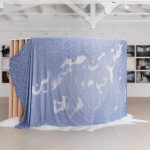After the Mediterranean is an exhibition curated by curator, writer and art researcher Oriol Fontdevila, which brings together seven artists whose work addresses the social and ecological challenges affecting the region: Erola Arcalís, Adjoa Armah, Laia Estruch, artist collective Huniti Goldox, Omar Mismar, Sara Ouhaddou and Abi Shehu. At the same time, After the Mediterranean introduces new thoughts and stories that testify to the human capacity to tackle the region’s challenges.
The exhibition thus brings together a group of artists, many of whom originate from, work within or in relation to territories bordering the Mediterranean. This includes among others Spanish, Albanian, French Moroccan and Lebanese artists. They present existing and new works, the latter created through a residency programme taking place in Menorca over the winter often in collaboration with local makers such as ceramicists and weavers. A public programme runs alongside the exhibition, engaging learning institutions, local organisations and communities, as well as the general public.
AFTER THE MEDITERRANEAN
Curatorial statement by Oriol Fontdevila
What will become of the Mediterranean in the next geological epoch? What will the thousands of migrants who venture across this sea –and the matter, the energy and the technologies which are traded from one side to the other– find beyond it? What representations will replace the idea of a bucolic sea?
After the Mediterranean conjures diverse futures to mobilise collective narratives around the human and ecological crises that impact the region. The artists in the exhibition confront areas of friction and introduce alternative accounts of the region through which a common world can be glimpsed.
The artists included address matters of concern within specific geographic contexts, technologies and systems of exchange, through which matter, humans and other species relate to one another and move from shore to shore. The purpose of this exhibition is to generate complex representations of the Mediterranean which are both global and local and allow us to understand this environment as simultaneously natural and social.
After the Mediterranean seeks to break away from dominant understandings of the region that have crystallised in the collective imagination. Firstly, there is the notion of the Mediterranean as a unitary sea: an understanding based on a single cultural tradition that has been imposed through successive waves of classicism referring to ancient Greece and Rome. Secondly, there is the notion of the Mediterranean as the sea of southern Europe: the idea of a mosaic of cultures which, despite their differences, are predisposed to coexist in harmony1.
While these two narratives respond to different chapters of European domination, After the Mediterranean seeks to problematise yet a third mode in which the region has been conceptualised more recently. This is the Mediterranean as conceived by the French historian Fernand Braudel. Employing the historiographical methodology of the ‘long durée’, Braudel explained that the Messinian salinity crisis—an intense period of drying which occurred five million years ago—induced biological poverty in the Mediterranean basin. This, in turn, enabled the proliferation of the fragile human species, the survival of which has depended on extensive networks of exchange, first regionally then globally2.
When the artists in the exhibition address the problems of the Mediterranean, they do so in terms of decolonialisation, aware as they are of the need to generate critical representations of the legacy of imperialism. Theirs are representations committed to the fight against the closing of European borders, against racial subjugation and global extractivism.
Moreover, when the artists undertake to analyse, deeply, controversies in their specificity and avoid producing new metaphors with which to simplify again the complexity of this ecosystem, they do so aware that the potential to challenge such determinations relies upon addressing areas of friction. These areas, although particular and even apparently ephemeral, are indications of transformative processes that could lead to the emergence of radically different futures.
The adverb ‘after’ in ‘After the Mediterranean’ refers precisely to this dialectic3: on the one hand, it expresses the urgency of detaching the present from the narratives through which the Mediterranean has been conceived until now. On the other, it points towards the need to summon future moments which are neither absolutely determined by the conditions of the present nor by the ancestral pasts of the ‘long durée’.
If there is any trace of hope within the projects of the exhibition, it is found in the oscillation between a rigorously critical work with the kinds of ‘Mediterraneans’ that one does not want to continue reproducing, and the projection of a series of ‘Mediterraneans’ that have not yet come to be.
[1] Chiara Cartuccia: ‘The space of a metaphor: on Mediterraneanism in the event-institution’. Afterall. n. 53. 2022
[2] Fernand Braudel: Memorias del Mediterráneo. Cátedra, 1997
[3] The expression ‘Després del Mediterrani’ originally comes from Cristina Lombardi-Diop’ foreword at: The Black Mediterranean Collective: Mediterráneo Negro. Cuerpos, fronteres y ciutadania. Katakrak, 2022
Press release and curatorial essay from Hauser & Wirth



